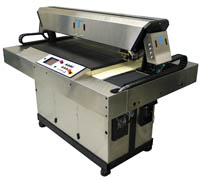
The printing industry has witnessed great strides in the advancement of inkjet inks. Technological progress has extended the application of inkjet printing into the realm of wide-format printers and beyond.1 Although several types of printing processes such as screen printing, offset printing, digital photo imaging and thermal transfer are known, inkjet technology provides a definite edge for end-users. To highlight a few, the ability to be used in different printhead technologies and to tailor end-user properties based on the ink and carrier media makes inkjet very attractive. The technology enables quick response to custom prints that can reduce expense on prepress process coupled with less ink waste. Inkjet technology is emerging as a leading digital imaging method for a variety of industrial applications such as graphic art, packaging, decorative and display device fabrication and also for security purposes and tracking systems.2
The market size has made the technology grow leaps and bounds over the last several years. Currently, solventborne inks are primarily used in industrial applications. The small home office inkjet system is exclusively waterborne. New developments in Piezo heads have enabled the use of alternative methods of application, leading to rapid growth of UV Inkjet technology within the printing industry.
UV Inkjet
In UV-curable inks, UV light is used to provide rapid curing upon transfer of the ink onto the substrate. UV-curable jetting chemistries are rapidly emerging as the next key enabler for piezo drop-on-demand (DOD) ink jet technology.3 The advantages of UV-curable inks over traditional types include:- absence of volatile organic compounds (VOCs);
- fast cure and low energy requirement;
- good chemical and solvent resistance;
- high gloss and vibrant colors;
- nozzles can be left uncapped for long periods of time as there are no solvents;
- significantly low rate of nozzle failure due to reduced nozzle blocking; and
- excellent adhesion to a wide variety of substrates.
Although UV-curable inks of a full process color system are relatively easy to formulate, a UV-curable white ink poses a real challenge. Herein, we highlight a technological breakthrough in a jettable UV-curable HexiJet™ White ink of high opacity and pigment loading with good settling stability.
Challenges for UV White Inkjet Ink
Demands on the formulator are numerous, as the UV-curable white ink needs to satisfy several requirements. From a formulation point of view, the following are some of the important properties: viscosity; surface tension; particle size; high opacity for the cured film; settling stability; cure speed; adhesion to several substrates; jet stability, i.e., low nozzle failure; and weatherability.Formulating an ink with the above requirements is a real challenge since some of them represent antagonistic relationships between performance and physical properties. Because of the small droplet size fired from DOD printheads, inks must be of low viscosity, which requires the use of monomers and low-viscosity oligomers. However, a high-opacity white ink also requires a high loading of inorganic pigments such as TiO2 and ZnS or a combination thereof. Due to the density differential between the monomer and the inorganic pigments, rapid settling is very much an inherent problem in these inks. Hence, settling and supernatant formation are unavoidable but the speed at which this occurs is sensitive to the components present in the ink.
Recently introduced HexiJet™ White ink is UV curable and is engineered for use in a piezo, DOD print head. Inks are formulated so as to provide excellent durability and highly opaque prints at high print speed operations. The unique chemistry in HexiJet™ White ink is optimized to provide good settling stability and excellent cure speed. Upon cure, the ink provides superior end-user properties such as flexibility, gloss, adhesion to various plastic substrates as well as intercoat adhesion. The ink is formulated to be in a low-viscosity range, and the ink's surface tension is optimized to provide good wetting both within the printhead and on the substrate.

Ink Properties
ViscosityViscosity plays a crucial role during the printing process and must be optimized to ensure maximum reliability and high print quality. HexiJet™ White ink has a viscosity range of 10-14 cps at jetting temperatures, which makes it an excellent candidate for piezoelectric printheads. Figure 1 shows a representative temperature/viscosity curve for the HexiJet™ White ink. Based on the high shear rheology experiments, the change in viscosity at the jetting temperatures is relatively minimal, permitting reliable jetting at a variety of temperatures.
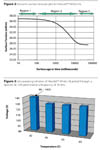
Surface Tension
Surface tension is an important property in relation to ink-jet technology. The surface tension dictates the position of the ink meniscus within the nozzle along with drop quality. If the ink surface tension is too low, it will result in excessive nozzle face plate wetting, which can impact jet reliability due to reduced ink ejection. Conversely, high surface tension can hinder droplet ejection due to insufficient wetting of printhead nozzle face plate. Furthermore, ink surface tension is also critical for wetting the substrate.Dynamic surface tension measurements were carried out on a Kruss BP2 tensiometer. The technique involves measuring the surface tension by varying the surface age for the sample from 10 to 50,000 msecs. It is known that jetting occurs in the microsecond timescale, whereas the lowest surface age measurable with the tensiometer is about 5-10 msecs. This surface age range relates to the inflight timeframe wherein the ink drop has ejected from the printhead nozzle before reaching the substrate. Longer surface ages of around 500-1,000 msecs relates to the timeframe wherein the ink drop has reached the substrate.
Figure 2 shows the dynamic surface tension curve for HexiJet™ White ink. The dynamic surface tension curve can be divided into three parts. The first equilibrium state (Region 1) represents values at low surface age, next a rate limiting stage (Region 2) and lastly a second equilibrium state (Region 3) represented by the static surface tension at high surface age. Ideally, at low surface age the ink should actually start to show a surface tension drop followed by a rapid change in slope. At longer time scale of up to 500 milliseconds the ink should reach an equilibrium value, which essentially is the static surface tension. After reaching this value, it is not expected to change further. All three stages described above will largely be dependent on the type of surfactant and its migratory process at different time scales after the moment the ink is fired from the printhead.
Our state-of-the-art dispersion technology provides the HexiJet™ White ink with surface tension in the range of 24-28 mN/m so as to provide good wetting characteristics both within the printhead and over a wide variety of substrates.

Jetting Performance
HexiJet™ White ink jet performance was investigated using several printheads such as XaarJet-500/180, Spectra Nova 256/80, and Spectra SM and SE-128 printhead under different operating conditions to determine the operating window. The jet-operating window describes the various parameters such as temperature, voltage and firing frequency under which the ink can be jetted reliably.The operating window of the HexiJet™ White ink in the SE 128 printhead at a firing frequency of 16 kHz is shown in Figure 3. It clearly shows that the white ink has a broad operating window. Reliable jetting can be achieved from 30 to 60 ºC and from 90 to 130 V.
In conjunction with jetting reliability, the ink was also investigated using an Optica X Plus vision system (Xennia Technology Ltd.). This system allows for the droplet breakup visualization as it is ejected from the faceplate. An individual nozzle of the faceplate ejecting droplets over a range of strobe delays was examined. The strobe allows one to see droplets in flight. The HexiJet™ White ink was examined with this system, and the image is depicted in Figure 4. It is evident from Figure 4 that the ligaments that are formed upon ejection from the nozzle combine with the drop to form an image without any satellites. The ink trajectory was straight, and the nozzles showed no sign of failure. The ink maintains optimum faceplate wetting to allow efficient drop break up. Currently, the HexiJet™ White ink has also been demonstrated to be applicable for grayscale Leopard printhead (manufactured by TTEC and distributed through Xaar).
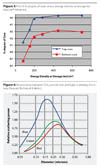
Cure Speed
HexiJet™ White ink is formulated to provide high opacity. However, this in turn can drastically affect the cure speed, especially the bottom cure. This is because TiO2 is a strong absorber of UV light.A 9-micron-thick coating of an ink was cured using a medium-pressure doped mercury (Hg) vapor lamp powered at 300 Watts per inch. Cure speed was determined using FTIR by measuring the peak area at 810 cm-1 for the ink and the cured film. A plot of cure speed versus energy density or dosage for the white ink is shown in Figure 5. The inks were formulated such that the cure is >90% for both top and bottom surfaces at and above an energy density of 200 mJ/cm2.

Opacity
Inorganic pigments such as TiO2 are commonly used as pigments in UV-curable white inks. The particle size of TiO2 plays a significant role in the opacity. Figure 6 shows the relative scattering power of red, green and blue light versus the particle size of TiO2. It is evident that scattering of the red, blue and green light is maximized at a particle size of 200-300 nm.The concentration of TiO2 can affect the opacity of the cured film. Figure 7 shows the relationship between opacity and percent TiO2 loading. The opacity increases almost linearly until a TiO2 content of 20% and then reaches a plateau. As the TiO2 concentration increases, diffractive light scattering decreases because of TiO2 particle overcrowding.
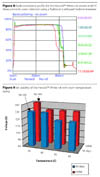
Settling Stability
One gauge of reliability in UV-curable inkjet inks is resistance to settling. Ink settling is usually measured along with aging to determine if the particles agglomerate or flocculate. UV-curable inkjet inks that resist settling are highly desirable. It reduces preparation time before usage, and hence agitation of ink before loading is not essential. Thus the ink may be left in the printhead for an extended period of time. All of this simplifies and expedites the start-up and the clean-up process.A key factor that leads to the settling of the white ink is the large density difference between the inorganic pigments and the ink vehicle. However, the unique chemistry in HexiJet™ White ink is optimized to provide ink with good settling stability. Figure 8 shows a representative aging profile for the HexiJet™ White ink. The ink was aged at 60 °C for an extended period of time. The overlay of the profiles is used to determine any pigment agglomeration. An ink is considered to have settled when the change in the backscattering is above 5%. The settling stability value obtained for the accelerated aged sample was converted to the equivalent stability at room temperature to obtain a stability of 50 days. It has to be pointed out that a gentle swirl, without the introduction of any air bubbles in the ink will maintain and extend settling shelf life. Particle size characterization also supports the finding that the inks remain stable over the time period.
In order to understand the significance of the sedimentometry results in realistic conditions, jet stability of the white ink was monitored using the Spectra head SE-128 printhead. Figure 9 shows the jet operating window for the 50-day aged sample versus the unaged sample. The results indicate no significant decrease in the jet-operating window over the temperature ranges, indicating a very stable ink.
Good settling stability for the HexiJet™ White ink is an attractive option for the end user since there is no need to invest in special printhead equipment requiring stirring or agitation. In fact, there was no loss of opacity for the printed sample after storage of the HexiJet™ White ink in the printhead for over seven days without any agitation. This ensures uniform end user properties for the cured film.
Summary
The HexiJet™ UV-curable white inkjet ink is a perfect example of Hexion Specialty Chemicals' commitment to discover better solutions for a better world. Our dedication to high-quality products and superior performance are evident in the low-viscosity, highly opaque, stable ink with robustness in the printhead while also providing excellent end-user properties on a wide variety of substrates. The commitment to quality products and service has been applied to the HexiJet™ line of UV-curable inkjet inks to provide customers with a superior product that provides advantages from the printhead to the production line and to the end user. Our team can custom-formulate products for specific applications, increase your company's printing capabilities and reduce your environmental impact with HexiJet™ UV-curable White inkjet ink. CAcknowledgement
The authors would like to acknowledge Dr. Stephen Sung of Hexion Specialty Chemicals, an expert in inkjet technology, for his valuable input related to dynamic surface tension and printhead technology.

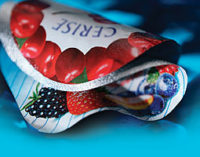
Report Abusive Comment